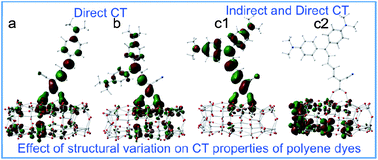A TD-DFT study of the effects of structural variations on the photochemistry of polyenedyes
Abstract
We report a TD-DFT study of three

- This article is part of the themed collection: Physical Chemistry
* Corresponding authors
a
The SFI SRC in Solar Energy Conversion, School of Chemical and Bioprocess Engineering, University College Dublin, Belfield, Dublin 4, Ireland
E-mail:
niall.english@ucd.ie, ravindranathan.thampi@ucd.ie
Tel: +353 1 716 1646
We report a TD-DFT study of three

 Please wait while we load your content...
Something went wrong. Try again?
Please wait while we load your content...
Something went wrong. Try again?
S. Agrawal, P. Dev, N. J. English, K. R. Thampi and J. M. D. MacElroy, Chem. Sci., 2012, 3, 416 DOI: 10.1039/C1SC00676B
To request permission to reproduce material from this article, please go to the Copyright Clearance Center request page.
If you are an author contributing to an RSC publication, you do not need to request permission provided correct acknowledgement is given.
If you are the author of this article, you do not need to request permission to reproduce figures and diagrams provided correct acknowledgement is given. If you want to reproduce the whole article in a third-party publication (excluding your thesis/dissertation for which permission is not required) please go to the Copyright Clearance Center request page.
Read more about how to correctly acknowledge RSC content.
 Fetching data from CrossRef.
Fetching data from CrossRef.
This may take some time to load.
Loading related content
